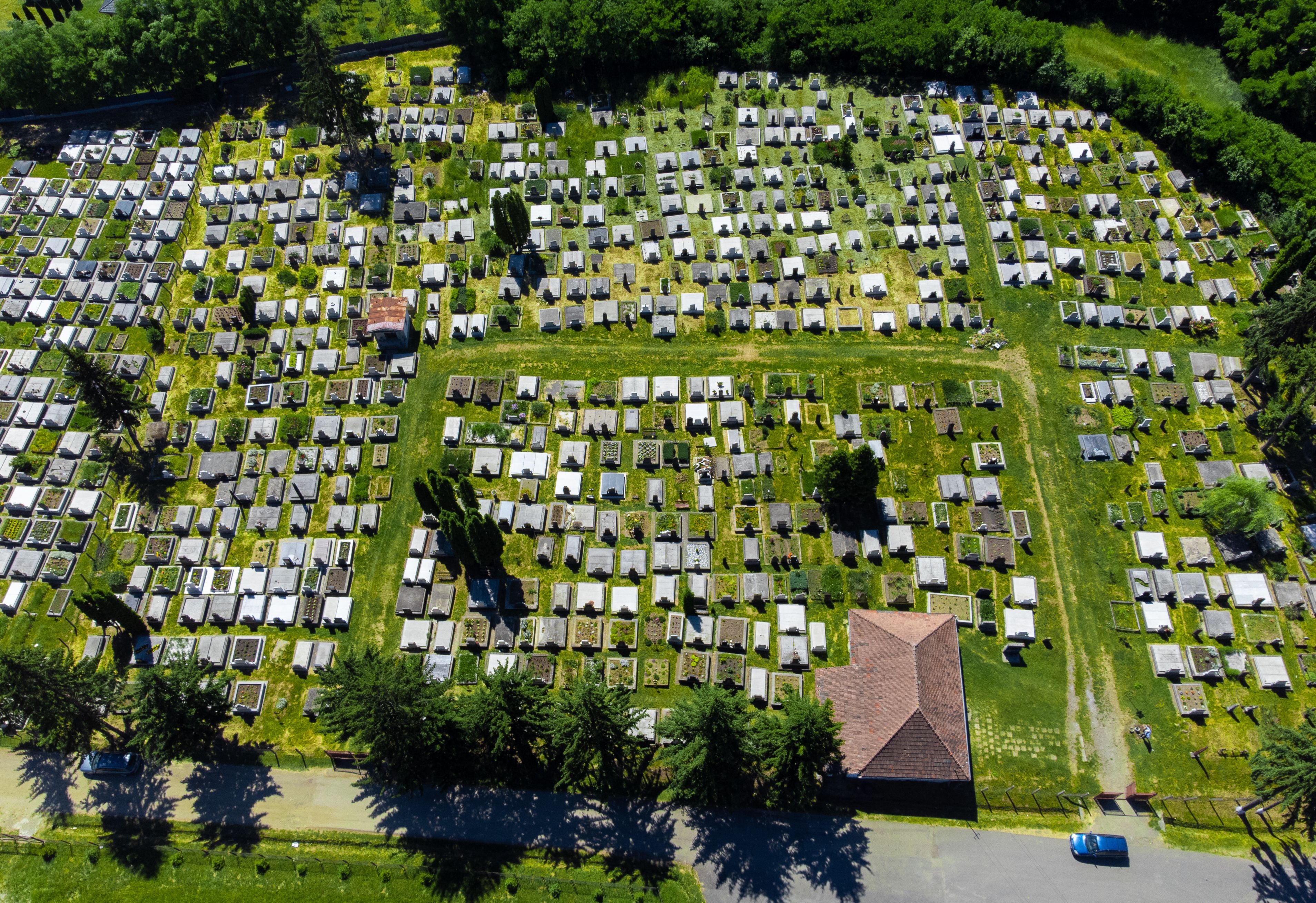
🪦 Memento Mori: Mapping Cemeteries
Don't let the idea of mapping your cemetery haunt you. In this post, we dive into the importance and process of digitizing and mapping cemeteries and the role technology plays in maintaining the legacy of both the cemetery and its residents. Don't get spooked by the task of too much work getting in your way of keeping your cemetery in the shape it deserves.
In my early 20s, I worked for the cemetery division of a city. I observed a workplace that we’ll all one day visit, but don’t know much about. From file cabinets full of information cards with site information to using outdated tools for customers to look up their loved one's location. Working for the cemetery department was a great experience, I also rode around on a lawn mower, listening to music all day. It was a pretty good job. As much as I loved the job, I noticed how out-of-date practices were. I noticed that record keeping was by spreadsheet. In the older cemetery that was almost at capacity, there were still file cabinets full of tap cards with each grave site's information. From date of birth to date of death and the cause of it. It made exploring at lunch very interesting. Even if all those records had been moved to a digital format, their physical copies were still there. The archived data that was taken before computers was kept in record books. What happens to those documents if a disaster happens? If a headstone is weathered and can no longer be read, how is that information found? How do you report that a headstone needs to be repaired? How are those records kept? There are many different types of cemetery management software out there, but how many cemeteries operated by municipalities purchase it? Can you think of how your city is currently managing that information?
When I began working in the GIS field, one of the first questions I asked was why cities weren’t digitally mapping their cemeteries and records. It seemed it would be the best solution to store information for future use. I thought it would be a good idea if one of our projects was to GPS map each grave location and add the headstone information. Unfortunately, that was never a project I got an opportunity to do. Fast forward to being hired at iamGIS, and having municipalities around the country ask if we have customers using the software to map their cemeteries and the best way to do it.
 Digitizing your cemetery can prove to be a tedious task, but once the initial work is complete, updating the map will only take a few clicks of your mouse. The most time-consuming portion of the project will be digitizing the data to the map. Most cemeteries do not have any digital information about their cemeteries. Those points will need to be GPS located in the field or digitized using a map showing locations. If a headstone is ever buried or weathered, you will always be able to find and access the information. With Digital mapping of the cemetery, you can include all information by customizing your data fields to tell all the needed information. From where the site is located, and which row it’s in, to any additional information on the site. Future sites can also be mapped before arrangements have been made. Once detailed information has been given, updates can be made to the digital map, including when the funeral is and the size of the site. This can make sure employees stay informed and there is no miscommunication.
Digitizing your cemetery can prove to be a tedious task, but once the initial work is complete, updating the map will only take a few clicks of your mouse. The most time-consuming portion of the project will be digitizing the data to the map. Most cemeteries do not have any digital information about their cemeteries. Those points will need to be GPS located in the field or digitized using a map showing locations. If a headstone is ever buried or weathered, you will always be able to find and access the information. With Digital mapping of the cemetery, you can include all information by customizing your data fields to tell all the needed information. From where the site is located, and which row it’s in, to any additional information on the site. Future sites can also be mapped before arrangements have been made. Once detailed information has been given, updates can be made to the digital map, including when the funeral is and the size of the site. This can make sure employees stay informed and there is no miscommunication.
Once your digital map is running, a shared view-only link can be given to the public. This link can be embedded into the cemetery website so residents who visit when offices are closed can still access the information, they need to find their loved ones. This can make their experience at the cemetery a smooth one. Any updates made to the map will be updated on the shared link in real-time.
Advancing Cemetery Preservation and Succession Plans with Technology
The preservation of cemeteries is not only a matter of maintaining historical and personal records; it's about honoring the memories of those who have passed and ensuring the comfort and ease of their loved ones when they visit. Embracing modern technology, specifically mapping and asset management tools, can revolutionize cemetery management and secure its success well into the future.
- Efficient Management and Planning
Digital mapping and asset management tools like iamGIS offer a centralized platform for efficient organization and planning within a cemetery. By accurately mapping grave sites and tracking assets like headstones, pathways, equipment, and infrastructure, cemetery administrators can optimize space, plan for future expansions, budget, and maintain a comprehensive view of the available resources.
- Preserving Historical and Personal Data
One of the critical aspects of cemetery management is preserving historical and personal data associated with each burial site. Our mapping tools enable the seamless digitization of this data, from birth and death dates to epitaphs and other pertinent details. This not only ensures the long-term preservation of valuable records but also allows for easy retrieval and accessibility for genealogists, historians, and families. You own your data and are able to retrieve it at your convenience.
- Streamlining Maintenance and Repairs
Headstones and monuments, like any physical structures, require maintenance and occasional repairs. Through our mapping and asset management tools, issues with headstones can be promptly identified, documented, and scheduled for repairs via work orders. This proactive approach ensures that the cemetery remains in a respectful and well-maintained condition, enhancing the overall visitor experience.
- Seamless Succession Planning
Planning for the future is essential for any organization, including cemeteries. With our tools, cemeteries can create comprehensive succession plans that outline the transfer of management, operational guidelines, and necessary information to successors. This smooth transition process helps maintain the continuity and prosperity of the cemetery, guaranteeing it remains a place of solace and remembrance for generations to come.
- Enhanced Visitor Experience
Empowering visitors with an intuitive and accessible digital map improves their overall experience when visiting the cemetery. They can easily locate their loved ones' resting places, access historical information, and navigate the grounds effortlessly. Providing a positive experience for visitors fosters a sense of community and encourages continued visits, supporting the long-term success and sustainability of the cemetery.
At iamGIS, we are committed to aiding cemeteries in their journey toward sustainable and memorable futures. By embracing technology, cemeteries can uphold their legacy, honoring the memories of those laid to rest and ensuring the continuation of their meaningful contributions to society.

